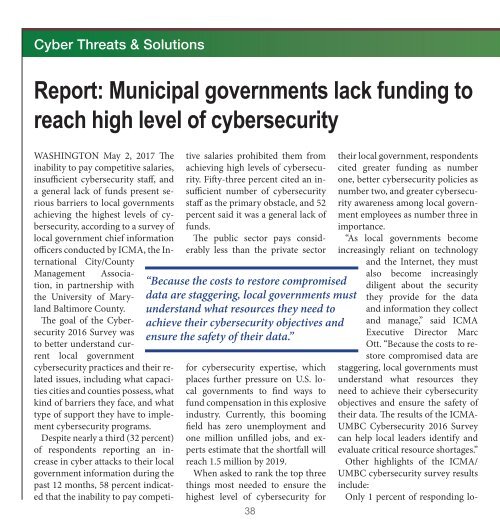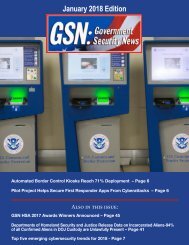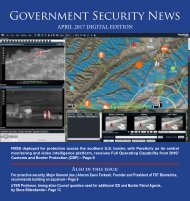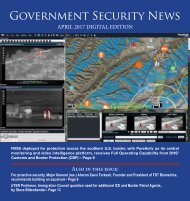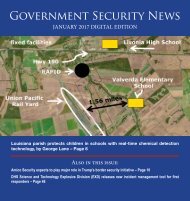GSN_Apr_FINAL+links
Create successful ePaper yourself
Turn your PDF publications into a flip-book with our unique Google optimized e-Paper software.
Page 1 of 12<br />
Cyber Threats & Solutions<br />
Report: Municipal governments lack funding to<br />
reach high level of cybersecurity<br />
WASHINGTON May 2, 2017 The<br />
inability to pay competitive salaries,<br />
insufficient cybersecurity staff, and<br />
a general lack of funds present serious<br />
barriers to local governments<br />
achieving the highest levels of cybersecurity,<br />
according to a survey of<br />
local government chief information<br />
officers conducted by ICMA, the International<br />
City/County<br />
Management Association,<br />
in partnership with<br />
the University of Maryland<br />
Baltimore County.<br />
The goal of the Cybersecurity<br />
2016 Survey was<br />
to better understand current<br />
local government<br />
cybersecurity practices and their related<br />
issues, including what capacities<br />
cities and counties possess, what<br />
kind of barriers they face, and what<br />
type of support they have to implement<br />
cybersecurity programs.<br />
Despite nearly a third (32 percent)<br />
of respondents reporting an increase<br />
in cyber attacks to their local<br />
government information during the<br />
past 12 months, 58 percent indicated<br />
that the inability to pay competitive<br />
salaries prohibited them from<br />
achieving high levels of cybersecurity.<br />
Fifty-three percent cited an insufficient<br />
number of cybersecurity<br />
staff as the primary obstacle, and 52<br />
percent said it was a general lack of<br />
funds.<br />
The public sector pays considerably<br />
less than the private sector<br />
“Because the costs to restore compromised<br />
data are staggering, local governments must<br />
understand what resources they need to<br />
achieve their cybersecurity objectives and<br />
ensure the safety of their data.”<br />
for cybersecurity expertise, which<br />
places further pressure on U.S. local<br />
governments to find ways to<br />
fund compensation in this explosive<br />
industry. Currently, this booming<br />
field has zero unemployment and<br />
one million unfilled jobs, and experts<br />
estimate that the shortfall will<br />
reach 1.5 million by 2019.<br />
When asked to rank the top three<br />
things most needed to ensure the<br />
highest level of cybersecurity for<br />
their local government, respondents<br />
cited greater funding as number<br />
one, better cybersecurity policies as<br />
number two, and greater cybersecurity<br />
awareness among local government<br />
employees as number three in<br />
importance.<br />
“As local governments become<br />
increasingly reliant on technology<br />
and the Internet, they must<br />
also become increasingly<br />
diligent about the security<br />
they provide for the data<br />
and information they collect<br />
and manage,” said ICMA<br />
Executive Director Marc<br />
Ott. “Because the costs to restore<br />
compromised data are<br />
staggering, local governments must<br />
understand what resources they<br />
need to achieve their cybersecurity<br />
objectives and ensure the safety of<br />
their data. The results of the ICMA-<br />
UMBC Cybersecurity 2016 Survey<br />
can help local leaders identify and<br />
evaluate critical resource shortages.”<br />
Other highlights of the ICMA/<br />
UMBC cybersecurity survey results<br />
include:<br />
Only 1 percent of responding lo-<br />
cal governments<br />
have a stand-alone<br />
cybersecurity department<br />
or unit.<br />
Primary responsibility<br />
for cybersecurity is most<br />
often located within the IT department.<br />
Roughly 62 percent of responding<br />
jurisdictions have developed a<br />
formal policy governing the use of<br />
personally-owned devices by governmental<br />
officials and employees.<br />
Nearly 70 percent of responding<br />
local governments have not developed<br />
a formal, written cybersecurity<br />
risk management plan, but nearly<br />
41 percent conduct an annual risk<br />
assessment and an additional 16<br />
percent take stock of their risk at<br />
least every two years.<br />
The Cybersecurity 2016 Survey<br />
was mailed (with an online option)<br />
to the chief information officers of<br />
3,423 U.S. municipalities and counties<br />
with populations of 25,000 or<br />
greater. Responses were received<br />
from 411 local governments for a<br />
response rate of 12 percent.<br />
Review the complete results of<br />
the survey at: http://icma.org/cybersecurity2016surveyresults.<br />
About ICMA<br />
ICMA, the International City/<br />
County Management Association,<br />
advances professional local government<br />
worldwide through leadership,<br />
management, innovation, and ethics.<br />
ICMA is second only to the federal<br />
government in the collection,<br />
analysis, and dissemination of data<br />
focused on issues related to local<br />
government management. Through<br />
expansive partnerships with local<br />
governments, federal agencies, nonprofits,<br />
and philanthropic funders,<br />
the organization gathers information<br />
on topics such as sustainability,<br />
health care, aging communities,<br />
38 39<br />
Introduction<br />
In 2016, the International City/County Management Association (ICMA), in partnership with the University of Maryland,<br />
Baltimore County (UMBC), conducted a survey to be ter understand local government cybersecurity practices. The<br />
results of this survey provide insights into the cybersecurity issues faced by U.S. local governments, including wha their<br />
capacities are, what kind of ba riers they face, and wha type of suppor they have to implement cybersecurity programs.<br />
Methodology<br />
The survey was sent on paper via postal mail to the chief information o ficers of 3,423 U.S. local governments with<br />
populations of 25,000 or greater. An online submission option was also made available to survey recipients.<br />
Responses were received from 411 of the governments surveyed, yielding a response rate of 12%. Cities were<br />
ove represented among respondents while counties were underrepresented. Similarly, higher percentage of responses<br />
received from larger communities compared to sma ler communities. Further, jurisdictions in the Mountain region of the<br />
U.S. were ove represented, while jurisdictions in the Mid-Atlantic and East South-Central regions were<br />
unde represented. The following report reflects trends among the unweighted survey responses, and should only be<br />
considered to be representative of the responding governments. Weighting should be applied to achieve representation<br />
of the broader survey population.<br />
Cybersecurity 2016 Survey<br />
Summary Report of Survey Results<br />
Cybersecurity 2016 Survey<br />
Number Surveyed Number Responding Response Rate<br />
Total 3423 411 12.0%<br />
Population Size<br />
Over 1,000,000 42 11 26.2%<br />
500,000 - 1,000,000 98 20 20.4%<br />
250,000 - 499,999 168 26 15.5%<br />
100,000 - 249,999 532 63 11.8%<br />
50,000 - 99,999 939 108 11.5%<br />
25,000 - 49,999 1644 183 11.1%<br />
Geographic Division<br />
New England 183 23 12.6%<br />
Mid-Atlantic 391 23 5.9%<br />
East North-Central 782 94 12.0%<br />
West North-Central 266 26 9.8%<br />
South Atlantic 541 79 14.6%<br />
East South-Central 253 20 7.9%<br />
West South-Central 354 41 11.6%<br />
Mountain 220 48 21.8%<br />
Pacific Coast 433 57 13.2%<br />
Type of Government<br />
Municipalities 1893 267 14.1%<br />
Counties 1530 144 9.4%<br />
economic development, homeland<br />
security, alternative service delivery,<br />
as well as performance measurement<br />
and management data on a<br />
variety of local government services—all<br />
of which support related<br />
training, education, and technical<br />
assistance.<br />
About the University of Maryland<br />
Baltimore County<br />
UMBC is a dynamic public research<br />
university integrating teaching, research,<br />
and service to benefit the<br />
citizens of Maryland. As an Honors<br />
University, the campus offers academically<br />
talented students a strong<br />
undergraduate liberal arts foundation<br />
that prepares them for graduate<br />
and professional study, entry into<br />
the workforce, and community service<br />
and leadership. UMBC emphasizes<br />
science, engineering, information<br />
technology, human services<br />
and public policy at the graduate<br />
level. UMBC contributes to the economic<br />
development of the State and<br />
the region through entrepreneurial<br />
initiatives, workforce training, K-16<br />
partnerships, and technology commercialization<br />
in collaboration with<br />
public agencies and the corporate<br />
community. UMBC is dedicated to<br />
cultural and ethnic diversity, social<br />
responsibility and lifelong learning.


